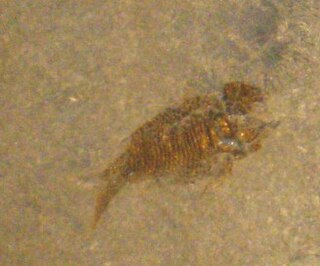
The Hepialidae are a family of insects in the lepidopteran order. Moths of this family are often referred to as swift moths or ghost moths.

Saurichthys is an extinct genus of predatory ray-finned fish from the Triassic Period. It is the type genus of the family Saurichthyidae, and the most speciose and longest lasting genus in the family. This family also includes the Permian Eosaurichthys (China) and the Jurassic Saurorhynchus from Europe and North America, though it may be more appropriate to treat these as subgenera of Saurichthys, due to the genus Saurichthys otherwise being paraphyletic.

Cycnorhamphus is a genus of gallodactylid ctenochasmatoid pterosaur from the Late Jurassic period of France and Germany, about 152 million years ago. It is synonymous with the genus Gallodactylus.

The Palaeonisciformes, commonly known as "palaeoniscoids" are an extinct grouping of primitive ray-finned fish (Actinopterygii), spanning from the Silurian/Devonian to the Cretaceous. They are generally considered paraphyletic, but their exact relationships to living ray-finned fish are uncertain. While some and perhaps most palaeoniscoids likely belong to the stem-group of Actinopteryii, it has been suggested that some may belong to the crown group, with some of these possibly related to Cladistia and/or Chondrostei. Many palaeoniscoids share a conservative body shape and a similar arrangement of skull bones, though paleoniscoids as a whole exhibit considerable diversity in body shape.

Alburnus is a genus of fish in the family Cyprinidae, the carps and minnows. They are known commonly as bleaks. A group of species in the genus is known as shemayas. The genus occurs in the western Palearctic realm, and the center of diversity is in Turkey.

Camaenidae is a family of air-breathing land snails, terrestrial pulmonate gastropod mollusks in the superfamily Helicoidea, the typical snails and their allies. This is one of the most diverse families in the clade Stylommatophora.

Birgeria is a genus of carnivorous marine ray-finned fish from the Triassic period. Birgeria had a global distribution, with fossil known from Madagascar, Spitsbergen, Germany, Switzerland, Italy, Slovenia, China, Russia, Canada and Nevada, United States. The oldest fossils are from Griesbachian aged beds of the Wordie Creek Formation of East Greenland. Birgeria existed throughout the entire Triassic period, from the very beginning just after the Permian-Triassic mass extinction, up to the very end with its extinction during the Triassic-Jurassic mass extinction.

Australosomus is an extinct genus of prehistoric ray-finned fish that lived during the Early Triassic epoch in what is now Greenland, Kenya, Tanzania, Madagascar, South Africa and Canada.

Bobasatrania is an extinct genus of prehistoric marine ray-finned fish that survived the Permian-Triassic extinction event. Fossils of Bobasatrania were found in beds of Changhsingian to Ladinian age. It was most speciose during the Early Triassic.

Khirbat Umm Burj was a Palestinian Arab village in the Hebron Subdistrict, sometimes designated in modern maps as Burgin. Its ruins are today located within the borders of Israel. It occupied an extensive site, stretching about 30 dunams on the crest of a hill, rising some 430 metres (1,410 ft) above sea level, and commanding a good prospect of the surrounding region. It was depopulated during the 1948 Arab–Israeli War on October 28, 1948, during the third stage of Operation Yo'av under the command of Yigal Allon. The site is located 17 km northwest of Hebron.

Macrosemiidae is an extinct family of ginglymodian fish. The family first appeared during the Middle Triassic and disappeared during the Late Cretaceous. The group has been found in rock formations in Africa, Australia, Eurasia and North America. As ginglymodians, their closest living relatives are gars, with them being typically placed as nested within the Semionotiformes. Many members of the family have elongated dorsal fins, often associated with adjacent area of skin which was free of scales. These fins were likely undulated for use in precision swimming. Their body morphology suggests that they were slow swimmers that were capable of maneuvering around complex topography, such as reef environments.

Saurichthyiformes is an extinct order of ray-finned fish which existed in Asia, Africa, Australia, Europe and North America, during the late Permian to early Middle Jurassic. Saurichthyiiformes comprise two families, Saurichthyidae and Yelangichthyidae. Yelangichthyidae is monotypic, containing only the genus Yelangichthys. The gar or needlefish-like Saurichthyidae is primarily known from the genus Saurichthys. Additionally, the subgenera SaurorhynchusCostasaurichthys, Eosaurichthys, Lepidosaurichthys, and Sinosaurichthys are frequently used to group species, and are sometimes considered separate genera. Species are known from both marine end freshwater deposits. They had their highest diversity during the Early and Middle Triassic. Their phylogenetic position is uncertain, while they have often been considered members of Chondrostei, and thus related to living sturgeons and paddlefish, phylogenetic analysis of well-preserved remains has considered this relationship equivocal. They may actually belong to the stem-group of Actinopterygii, and thus not closely related to any living group of ray-finned fish.

Perleidiformes are an extinct order of prehistoric ray-finned fish from the Triassic period Although numerous Triassic taxa have been referred to Perleidiformes, which ones should be included for it to form a monophyletic group is a matter of ongoing scientific debate.

Ptycholepiformes are an extinct order of prehistoric ray-finned fish that existed during the Triassic period and the Early Jurassic epoch. The order includes the genera Acrorhabdus, Ardoreosomus, Boreosomus, Chungkingichthys, Ptycholepis, and Yuchoulepis. Although several families have been proposed, some studies place all these genera in the same family, Ptycholepididae.

Bobasatraniiformes is an extinct order of durophagous ray-finned fish that existed from the late Permian to the Middle Triassic in both marine and freshwater environments. The order includes two families: Bobasatraniidae, with the genera Bobasatrania, Ebenaqua, and Ecrinesomus, and Dorypteridae, comprising only the genus Dorypterus (monotypy). Bobasatraniiformes had a somewhat global distribution; fossils are found in Africa (Madagascar), Asia (Pakistan), Australia, Europe, and North America.
Peltopleuriformes is an extinct order of ray-finned fish.

Peltopleuridae were an extinct family of prehistoric bony fish. It is classified with the order Peltopleuriformes.

Thoracopteridae is an extinct family of prehistoric bony fish classified with the order Peltopleuriformes, containing four genera: Thoracopterus, Gigantopterus, Potanichthys and Italopterus. This lineage of Triassic flying fish-like Perleidiformes converted their pectoral and pelvic fins into broad wings very similar to those of their modern counterparts. However, this group is not related to modern flying fish from the family Exocoetidae, instead being a case of convergent evolution.

Parasemionotiformes is an extinct order of neopterygian ray-finned fish that existed globally during the Triassic period. It comprises the families Parasemionotidae and Promecosominidae. Many of the included genera are monotypic and most species lived during the Early Triassic epoch.

Nemocardium is a genus of bivalves belonging to the family Cardiidae.
























